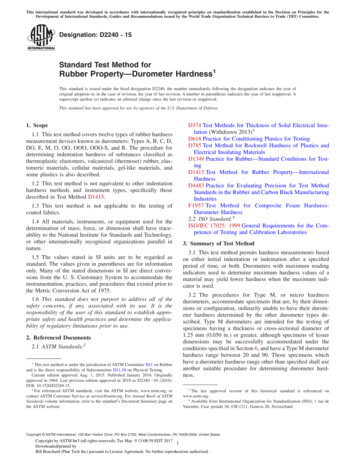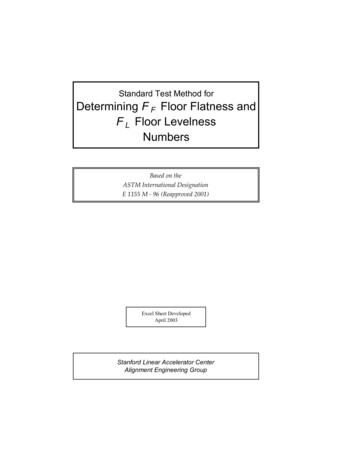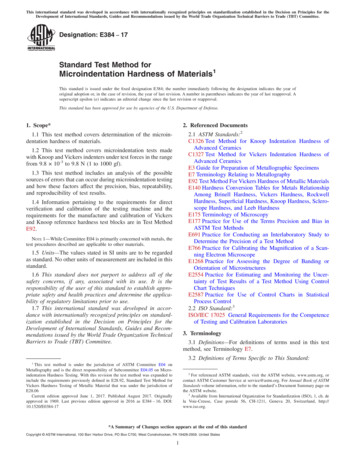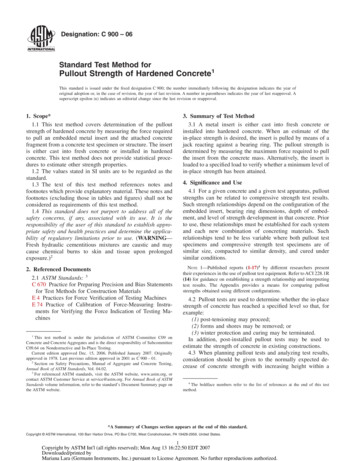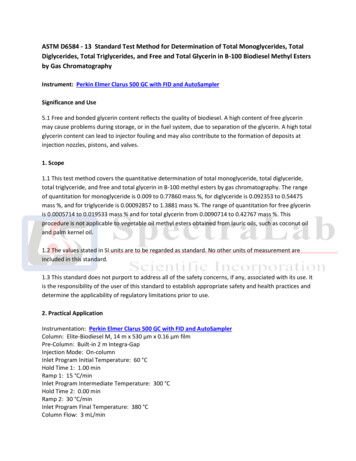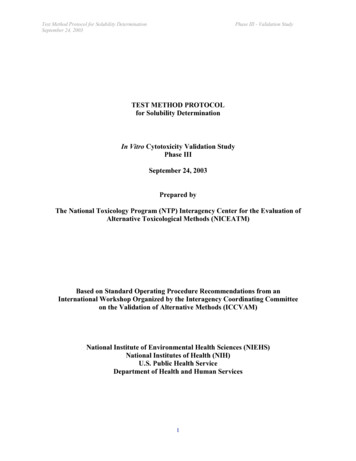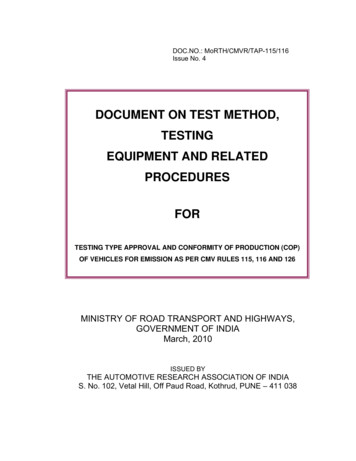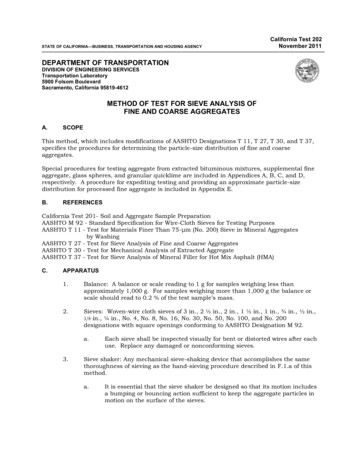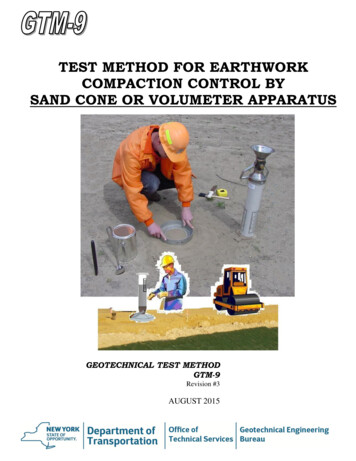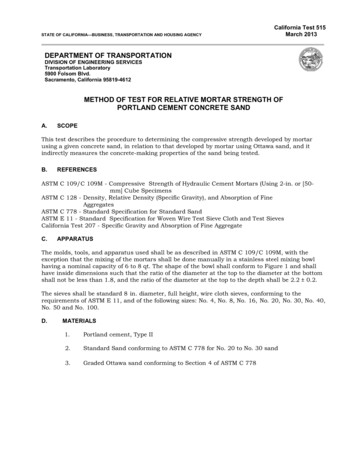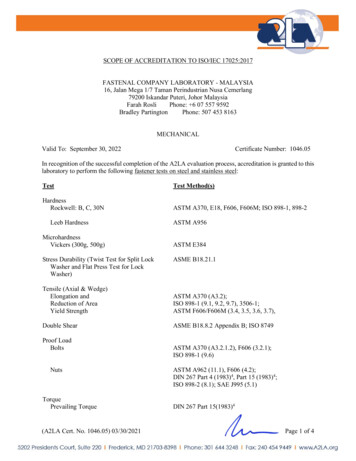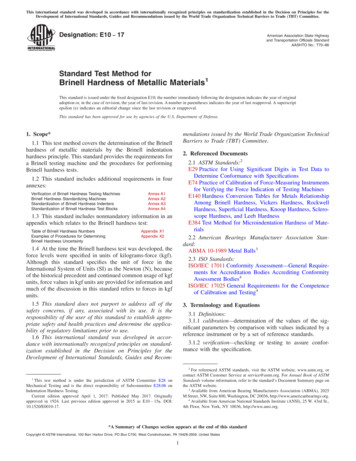
Transcription
This international standard was developed in accordance with internationally recognized principles on standardization established in the Decision on Principles for theDevelopment of International Standards, Guides and Recommendations issued by the World Trade Organization Technical Barriers to Trade (TBT) Committee.Designation: E10 17American Association State Highwayand Transportation Officials StandardAASHTO No.: T70–86Standard Test Method forBrinell Hardness of Metallic Materials1This standard is issued under the fixed designation E10; the number immediately following the designation indicates the year of originaladoption or, in the case of revision, the year of last revision. A number in parentheses indicates the year of last reapproval. A superscriptepsilon ( ) indicates an editorial change since the last revision or reapproval.This standard has been approved for use by agencies of the U.S. Department of Defense.mendations issued by the World Trade Organization TechnicalBarriers to Trade (TBT) Committee.1. Scope*1.1 This test method covers the determination of the Brinellhardness of metallic materials by the Brinell indentationhardness principle. This standard provides the requirements fora Brinell testing machine and the procedures for performingBrinell hardness tests.2. Referenced Documents2.1 ASTM Standards:2E29 Practice for Using Significant Digits in Test Data toDetermine Conformance with SpecificationsE74 Practice of Calibration of Force-Measuring Instrumentsfor Verifying the Force Indication of Testing MachinesE140 Hardness Conversion Tables for Metals RelationshipAmong Brinell Hardness, Vickers Hardness, RockwellHardness, Superficial Hardness, Knoop Hardness, Scleroscope Hardness, and Leeb HardnessE384 Test Method for Microindentation Hardness of Materials2.2 American Bearings Manufacturer Association Standard:ABMA 10-1989 Metal Balls32.3 ISO Standards:ISO/IEC 17011 Conformity Assessment—General Requirements for Accreditation Bodies Accrediting ConformityAssessment Bodies4ISO/IEC 17025 General Requirements for the Competenceof Calibration and Testing41.2 This standard includes additional requirements in fourannexes:Verification of Brinell Hardness Testing MachinesBrinell Hardness Standardizing MachinesStandardization of Brinell Hardness IndentersStandardization of Brinell Hardness Test BlocksAnnex A1Annex A2Annex A3Annex A41.3 This standard includes nonmandatory information in anappendix which relates to the Brinell hardness test:Table of Brinell Hardness NumbersExamples of Procedures for DeterminingBrinell Hardness UncertaintyAppendix X1Appendix X21.4 At the time the Brinell hardness test was developed, theforce levels were specified in units of kilograms-force (kgf).Although this standard specifies the unit of force in theInternational System of Units (SI) as the Newton (N), becauseof the historical precedent and continued common usage of kgfunits, force values in kgf units are provided for information andmuch of the discussion in this standard refers to forces in kgfunits.1.5 This standard does not purport to address all of thesafety concerns, if any, associated with its use. It is theresponsibility of the user of this standard to establish appropriate safety and health practices and determine the applicability of regulatory limitations prior to use.1.6 This international standard was developed in accordance with internationally recognized principles on standardization established in the Decision on Principles for theDevelopment of International Standards, Guides and Recom-3. Terminology and Equations3.1 Definitions:3.1.1 calibration—determination of the values of the significant parameters by comparison with values indicated by areference instrument or by a set of reference standards.3.1.2 verification—checking or testing to assure conformance with the specification.2For referenced ASTM standards, visit the ASTM website, www.astm.org, orcontact ASTM Customer Service at service@astm.org. For Annual Book of ASTMStandards volume information, refer to the standard’s Document Summary page onthe ASTM website.3Available from American Bearing Manufacturers Association (ABMA), 2025M Street, NW, Suite 800, Washington, DC 20036, http://www.americanbearings.org.4Available from American National Standards Institute (ANSI), 25 W. 43rd St.,4th Floor, New York, NY 10036, http://www.ansi.org.1This test method is under the jurisdiction of ASTM Committee E28 onMechanical Testing and is the direct responsibility of Subcommittee E28.06 onIndentation Hardness Testing.Current edition approved April 1, 2017. Published May 2017. Originallyapproved in 1924. Last previous edition approved in 2015 as E10 – 15a. DOI:10.1520/E0010-17.*A Summary of Changes section appears at the end of this standardCopyright ASTM International, 100 Barr Harbor Drive, PO Box C700, West Conshohocken, PA 19428-2959. United States1
E10 173.2 Equations:3.2.1 The Brinell hardness number is calculated as:3.1.3 standardization—to bring in conformance with aknown standard through verification or calibration.3.1.4 Brinell hardness test—an indentation hardness testusing a verified machine to force an indenter (tungsten carbideball with diameter D), under specified conditions, into thesurface of the material under test. The diameter of the resultingindentation d is measured after removal of the force.3.1.5 Brinell hardness number—a number, which is proportional to the quotient obtained by dividing the test force by thecurved surface area of the indentation which is assumed to bespherical and of the diameter of the ball.3.1.6 Brinell hardness scale—a designation that identifiesthe specific combination of ball diameter and applied forceused to perform the Brinell hardness test.3.1.7 Brinell hardness testing machine—a Brinell hardnessmachine used for general testing purposes.3.1.8 Brinell hardness standardizing machine—a Brinellhardness machine used for the standardization of Brinellhardness test blocks. The standardizing machine differs from aregular Brinell hardness testing machine by having tightertolerances on certain parameters.3.1.9 force-diameter ratio—a number calculated as the ratioof the test force in kgf to the square of the indenter balldiameter in mm (see Table 1).HBW 52F kgf πD D 2 D 2 2 d 2!(1)where:Fkgf test force in kgf,D diameter of the indenter ball in mm, andd measured mean diameter of the indentation in mm(see Table 1).3.2.2 The average mean diameter d̄ of a set of n indentationsis calculated as:d̄ 5d 1 1d 2 1 1d nn(2)where:d1, d2, . dn diameter values of the indentations in mm,andn number of indentations (see Annex A4).3.2.3 The repeatability R in the performance of a Brinellhardness machine at each hardness level, under the particularverification conditions, is estimated by the percent range ofdiameter values of n indentations made on a standardized testblock as part of a performance verification, relative to theaverage of the n measured diameter values d̄ (Eq 2), defined as:TABLE 1 Symbols and DesignationsSymbolDesignationDDiameter of the ball, mmFTest force, NFkgfR 5 100 313Fgnwhere gn is the acceleration due to gravity.gn 9.80665 N/kgfdd s 1 d 1d s 2 d 1{1d s N dNH̄ 5where d(1), d(2) . d(N) are the measured indentationdiameters in mm, and N is the number of diameter measurements (typically 2).hForceDiameterratioHBWD 2 œD 2 2 d 225F kgfD2E 5 100 3Brinell hardness(4)S?DH̄ 2 H STDH STD(5)where:H̄ (Eq 4) average of n hardness tests H1, H2, ., Hn madeon a standardized test block as part of a performance verification, certified average hardness value of the standardHSTDized test block, andTest Force5Surface area of indentation5H 1 1H 2 1 1H nn3.2.5 The error E in the performance of a Brinell hardnessmachine at each hardness level, under the particular verification conditions, is estimated by the percent error of the averageof n indentation measurements made on a standardized testblock as part of a performance verification relative to thecertified average hardness value of the standardized test block,defined as:Depth of the indentation, mmh5(3)3.2.4 The average H̄ of a set of n Brinell hardness measurementvalues H1, H2, ., Hn is calculated as:Diameter value of the indentation, mmd5d̄where:dmax diameter value of the largest measured indentationdmin diameter value of the smallest measured indentation,andd̄ (Eq average of the diameter values of the n indentations.2)Test force, kgfF kgf 5d max 2 d min2F kgfπ D s D 2 œD 2 2 d 2 d2
E10 175.2.1 See the Equipment Manufacturer’s Instruction Manualfor a description of the machine’s characteristics, limitations,and respective operating procedures.5.2.2 Anvils—An anvil, or specimen support, should be usedthat is suitable for the specimen to be tested. The seating andsupporting surfaces of all anvils should be clean and free offoreign material. Typically, anvils need only be replaced if theyfail to support the test surface perpendicular to the indenter, orthey are deemed unsafe.5.2.3 Indenters—Indenters for the Brinell hardness test shallbe tungsten carbide balls of four allowed diameters (1, 2.5, 5and 10 mm). Indenters shall meet the requirements defined inAnnex A3.5.2.4 Oil, dirt, or other foreign materials shall not beallowed to accumulate on the indenter, as this will affect thetest results.5.2.5 Measurement Device—The measurement device usedfor the measurement of the diameter of Brinell indentationsmay be an integral part of the hardness machine or a separatestand-alone instrument. The allowable measurement devicesare classified into two types. The Type A device includesmicroscopes having movable measuring lines with some typeof indicator or computerized measuring system, or an imageanalysis system. The Type B device is a hand-held microscope(usually 20 or 40 ) with fixed measuring lines.5.2.5.1 Type A Device—The acceptable minimum resolutionfor a Type A device shall be as given in Table 2.5.2.5.2 Type B Device—The acceptable maximum spacingbetween the graduated lines of Type B devices shall be as givenin Table 2. Type B devices shall not be used for measuringindentations made with 2.5 mm and 1 mm ball indenters. H̄2H STD absolute value (non-negative value without regard to its sign) of the difference between H̄ andHSTD.4. Significance and Use4.1 The Brinell hardness test is an indentation hardness testthat can provide useful information about metallic materials.This information may correlate to tensile strength, wearresistance, ductility, or other physical characteristics of metallic materials, and may be useful in quality control and selectionof materials.4.2 Brinell hardness tests are considered satisfactory foracceptance testing of commercial shipments, and have beenused extensively in industry for this purpose.4.3 Brinell hardness testing at a specific location on a partmay not represent the physical characteristics of the whole partor end product.5. Principles of Test and Apparatus5.1 Brinell Hardness Test Principle—The general principleof the Brinell indentation hardness test consists of two steps(see Fig. 1).5.1.1 Step 1—The indenter is brought into contact with thetest specimen in a direction perpendicular to the surface, andthe test force F is applied. The test force is held for a specifieddwell time and then removed.5.1.2 Step 2—The diameter of the indentation is measuredin at least two directions perpendicular to each other. TheBrinell hardness value is derived from the mean of the diametermeasurements.5.3 Verification—Brinell testing machines and indentationmeasurement devices shall be verified periodically in accordance with Annex A1.5.2 Brinell Testing Machine—Equipment for Brinell hardness testing usually consists of a testing machine, whichsupports the test specimen and applies an indenting force to aball in contact with the specimen, and a system for measuringthe mean diameter of the indentation in accordance with theBrinell hardness test principle. The design of the testingmachine shall be such that no rocking or lateral movement ofthe indenter or specimen occurs while the force is beingapplied. The design of the testing machine shall ensure that theforce to the indenter is applied smoothly and without impactforces. Precautions shall be taken to prevent a momentary hightest force caused by the inertia of the system, hydraulic systemovershoot, etc.5.4 Test Blocks—Test blocks meeting the requirements ofAnnex A4 shall be used to verify the testing machine inaccordance with Annex A1.5.5 Brinell Hardness Scales—The combinations of indenters and test forces define the Brinell hardness scales. Thestandard Brinell hardness scales and test forces are given inTable 3, corresponding to force-diameter ratios (see Table 1) of1, 1.25, 2.5, 5, 10 and 30. Brinell hardness values should bedetermined and reported in accordance with one of thesestandard scales. Other scales using non-standard test forcesmay be used by special agreement. Examples of other scalesand the corresponding force-diameter ratio (in parentheses) areTABLE 2 Resolution and Graduation Spacing of IndentationMeasuring DevicesFIG. 1 Principle of Test3Type AType BBall DiametermmMinimumIndicator ResolutionmmMaximumGraduation ––
E10 17TABLE 3 Test Conditions and Recommended Hardness RangeBrinellHardnessScaleHBW 10/3000HBW 10/1500HBW 10/1000HBW 10/500HBW 10/250HBW 10/125HBW 10/100HBW 5/750HBW 5/250HBW 5/125HBW 5/62.5HBW 5/31.25HBW 5/25HBW 2.5/187.5HBW 2.5/62.5HBW 2.5/31.25HBW 2.5/15.625HBW 2.5/7.8125HBW 2.5/6.25HBW 1/30HBW 1/10HBW 1/5HBW 1/2.5HBW 1/1.25HBW 3.983.1895.52.52.5105612.9306.562.531.2531.8 to 21815.9 to 1092.52.5153.215.6257.96 to 54.52.51.2576.617.81253.98 to 27.22.51111111301052.51.25161
5.2 Brinell Testing Machine—Equipment for Brinell hard-ness testing usually consists of a testing machine, which supports the test specimen and applies an indenting force to a ball in contact with the specimen, and a system for measuring the mean diameter of the indentation in accordance with the Brinell hardness test principle. The design of the testingFile Size: 282KBPage Count: 32
